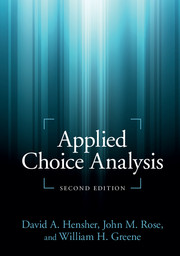Book contents
- Frontmatter
- Contents
- List of Figures
- List of Tables
- Preface
- Part I Getting started
- 1 In the beginning
- 2 Choosing
- 3 Choice and utility
- 4 Families of discrete choice models
- 5 Estimating discrete choice models
- 6 Experimental design and choice experiments
- 7 Statistical inference
- 8 Other matters that analysts often inquire about
- Part II Software and data
- Part III The suite of choice models
- Part IV Advanced topics
- Select glossary
- References
- Index
4 - Families of discrete choice models
from Part I - Getting started
Published online by Cambridge University Press: 05 June 2015
- Frontmatter
- Contents
- List of Figures
- List of Tables
- Preface
- Part I Getting started
- 1 In the beginning
- 2 Choosing
- 3 Choice and utility
- 4 Families of discrete choice models
- 5 Estimating discrete choice models
- 6 Experimental design and choice experiments
- 7 Statistical inference
- 8 Other matters that analysts often inquire about
- Part II Software and data
- Part III The suite of choice models
- Part IV Advanced topics
- Select glossary
- References
- Index
Summary
Introduction
The purpose of Chapter 3 was to provide an introduction to models estimated on data with categorical dependent variables. In doing so, we demonstrated how more commonly known model frameworks, such as the linear regression model, are inappropriate for this type of data. The model estimated on discrete choice data must accommodate the nature of the process that generates the data. The observed data on choices reveal, in discrete categorical form, the preferences of the individual over a discrete set of alternatives. The preferences, in turn, are embodied in latent continuous variables, termed utilities, that express the intensity of those preferences. The observed outcomes reveal only the relative preferences for the set of alternatives being modeled. If the latent preferences were observable we could, in principle, analyze them with regression methods. When only relative preferences, expressed in discrete outcomes, are revealed, different methods are called for.
As shown in Chapter 3, the analyst can specify a set of utility functions associated with the alternatives being modeled. Each utility function was shown to consist of two components, an observed component and an unobserved component. Chapter 3 focused on the observable components of the model of utility. Through their informed specification, the analyst has control over this part, being able to determine which variables enter into it, and how. Chapter 3 discussed the various choices analysts have available in specifying the observed component of utility for discrete choice models, including specifying generic and alternative specific parameters, using non-linear coding, and using linear and non-linear functions of data and parameters. Chapter 3 also mentioned two types of econometric models, probit and logit, which are based on two different specifications of the random parts of the utility functions in the random utility models of interest in this chapter.
- Type
- Chapter
- Information
- Applied Choice Analysis , pp. 80 - 116Publisher: Cambridge University PressPrint publication year: 2015



